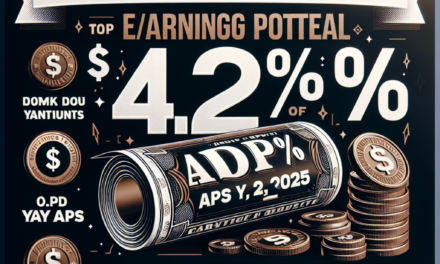“Unlock Financial Freedom: Invest in the Top 3 Dividend Stocks for Endless Passive Income!”
Introduction
Investing in dividend stocks is a popular strategy for those seeking a reliable stream of passive income. Dividend stocks are shares in companies that regularly distribute a portion of their earnings to shareholders, typically on a quarterly basis. This can provide investors with a steady income, in addition to any potential capital gains from the appreciation of the stock’s value. Among the myriad of options available, three top dividend stocks stand out for their strong track records, financial stability, and commitment to returning value to shareholders. These companies not only offer attractive dividend yields but also have the potential for long-term growth, making them ideal choices for investors looking to build a sustainable passive income portfolio.
Understanding Dividend Stocks: A Path to Passive Income
Dividend stocks have long been a cornerstone for investors seeking a reliable stream of passive income. By investing in companies that regularly distribute a portion of their earnings to shareholders, investors can enjoy a steady cash flow without having to sell their shares. This approach not only provides financial stability but also allows for the potential growth of capital over time. Understanding the nuances of dividend stocks is crucial for anyone looking to build a sustainable income stream. In this context, three top dividend stocks stand out for their ability to generate endless passive income: Johnson & Johnson, Procter & Gamble, and Coca-Cola.
To begin with, Johnson & Johnson is a stalwart in the healthcare sector, renowned for its diverse range of products spanning pharmaceuticals, medical devices, and consumer health goods. The company’s robust business model and consistent performance have enabled it to maintain a strong dividend payout history. Johnson & Johnson has increased its dividend for over 50 consecutive years, earning it the prestigious title of a Dividend King. This impressive track record is underpinned by the company’s commitment to innovation and its ability to adapt to changing market dynamics. As healthcare remains an essential industry with growing demand, Johnson & Johnson is well-positioned to continue delivering reliable dividends to its shareholders.
Transitioning to the consumer goods sector, Procter & Gamble is another exemplary dividend stock. Known for its extensive portfolio of trusted brands, including Tide, Pampers, and Gillette, Procter & Gamble has established itself as a leader in the consumer staples industry. The company’s focus on quality and brand loyalty has translated into consistent revenue streams, allowing it to reward shareholders with regular dividend payments. Like Johnson & Johnson, Procter & Gamble is also a Dividend King, having increased its dividend for over six decades. This remarkable achievement reflects the company’s resilience and strategic acumen in navigating economic cycles. As consumer staples remain a fundamental part of everyday life, Procter & Gamble’s dividends are likely to remain a dependable source of passive income.
Finally, Coca-Cola represents a compelling choice in the beverage industry for dividend-seeking investors. With a brand recognized worldwide, Coca-Cola has built a formidable presence in the global market. The company’s extensive distribution network and diverse product offerings have enabled it to maintain a strong financial position, even in challenging economic environments. Coca-Cola’s commitment to returning value to shareholders is evident in its long history of dividend payments, which have been consistently increased for over 50 years. This dedication to shareholder returns, coupled with the company’s strategic initiatives to expand its product line and adapt to changing consumer preferences, positions Coca-Cola as a reliable dividend stock.
In conclusion, dividend stocks offer a viable path to generating passive income, and Johnson & Johnson, Procter & Gamble, and Coca-Cola exemplify the qualities investors should seek. These companies have demonstrated resilience, strategic foresight, and a commitment to rewarding shareholders, making them ideal candidates for those looking to build a sustainable income stream. By investing in such well-established dividend stocks, investors can enjoy the benefits of regular income while also participating in the potential growth of these industry leaders. As always, it is essential for investors to conduct thorough research and consider their financial goals before making investment decisions.
Analyzing the Top Dividend Stocks for Long-Term Gains
When considering investment strategies for long-term financial growth, dividend stocks often emerge as a compelling option. These stocks not only provide the potential for capital appreciation but also offer regular income through dividends, making them an attractive choice for investors seeking passive income. In this context, identifying the top dividend stocks becomes crucial for maximizing returns and ensuring financial stability. Among the myriad of options available, three dividend stocks stand out for their consistent performance and potential for endless passive income: Johnson & Johnson, Procter & Gamble, and Coca-Cola.
To begin with, Johnson & Johnson is a stalwart in the healthcare sector, renowned for its diversified portfolio that spans pharmaceuticals, medical devices, and consumer health products. This diversification not only mitigates risk but also ensures a steady revenue stream, which is crucial for sustaining dividend payouts. Johnson & Johnson has a long-standing history of dividend increases, having raised its dividend for over 60 consecutive years. This track record of reliability makes it a cornerstone for any dividend-focused portfolio. Furthermore, the company’s robust financial health, underscored by its strong balance sheet and consistent cash flow, provides a solid foundation for future dividend growth. As healthcare remains an essential industry with enduring demand, Johnson & Johnson is well-positioned to continue delivering value to its shareholders.
Transitioning to the consumer goods sector, Procter & Gamble is another exemplary dividend stock that merits attention. Known for its extensive range of trusted brands, including Tide, Pampers, and Gillette, Procter & Gamble has established a formidable presence in households worldwide. This global reach, coupled with its ability to innovate and adapt to changing consumer preferences, ensures a resilient business model. Procter & Gamble’s commitment to returning value to shareholders is evident in its impressive dividend history, having increased its dividend for over 60 consecutive years. The company’s strategic focus on cost efficiency and market expansion further bolsters its capacity to sustain and grow dividends. As consumer staples remain a fundamental part of daily life, Procter & Gamble’s stability and growth prospects make it a reliable choice for dividend investors.
Finally, Coca-Cola represents a quintessential dividend stock within the beverage industry. With its iconic brand and extensive distribution network, Coca-Cola has maintained a dominant market position for decades. The company’s ability to generate substantial cash flow is a testament to its operational efficiency and brand strength. Coca-Cola’s commitment to rewarding shareholders is reflected in its track record of increasing dividends for over 60 years. Moreover, the company’s strategic initiatives to diversify its product offerings and expand into emerging markets provide additional avenues for growth. As the global demand for beverages continues to rise, Coca-Cola’s enduring appeal and financial resilience make it a compelling option for those seeking consistent passive income.
In conclusion, Johnson & Johnson, Procter & Gamble, and Coca-Cola exemplify the qualities of top dividend stocks that can provide endless passive income. Their strong financial foundations, commitment to shareholder returns, and strategic positioning within their respective industries underscore their potential for long-term gains. By incorporating these stocks into a diversified investment portfolio, investors can benefit from both capital appreciation and a reliable income stream, ultimately achieving their financial goals with greater confidence.
How to Choose the Best Dividend Stocks for Your Portfolio
When considering the addition of dividend stocks to your investment portfolio, it is crucial to adopt a strategic approach to ensure a steady stream of passive income. Dividend stocks, known for their ability to provide regular income through profit distribution, can be a valuable component of a well-rounded investment strategy. However, selecting the right dividend stocks requires careful analysis and consideration of several key factors. By understanding these factors, investors can make informed decisions that align with their financial goals and risk tolerance.
To begin with, one of the primary considerations when choosing dividend stocks is the company’s dividend yield. The dividend yield, expressed as a percentage, indicates how much a company pays out in dividends relative to its stock price. While a high dividend yield may seem attractive, it is essential to assess whether the yield is sustainable. A yield that is significantly higher than the industry average may signal potential financial instability or an unsustainable payout ratio. Therefore, it is advisable to look for companies with a consistent history of paying dividends and a yield that aligns with industry norms.
In addition to the dividend yield, the payout ratio is another critical factor to evaluate. The payout ratio measures the proportion of earnings a company distributes as dividends. A lower payout ratio suggests that a company retains a significant portion of its earnings for reinvestment, which can be a positive indicator of future growth potential. Conversely, a high payout ratio may indicate that a company is distributing most of its earnings, leaving little room for reinvestment or growth. Ideally, investors should seek companies with a balanced payout ratio that reflects both a commitment to rewarding shareholders and a focus on sustainable growth.
Furthermore, the financial health and stability of a company play a pivotal role in determining its suitability as a dividend stock. Companies with strong balance sheets, characterized by manageable debt levels and ample cash reserves, are better positioned to weather economic downturns and continue paying dividends. Analyzing financial statements and key metrics such as the debt-to-equity ratio and cash flow can provide valuable insights into a company’s financial stability. Additionally, companies with a track record of consistent revenue and earnings growth are more likely to sustain and potentially increase their dividend payments over time.
Moreover, it is important to consider the industry and market conditions in which a company operates. Certain industries, such as utilities and consumer staples, are known for their stability and resilience, making them attractive options for dividend investors. These sectors often exhibit less volatility and provide essential goods and services, ensuring a steady demand regardless of economic fluctuations. On the other hand, industries that are highly cyclical or subject to rapid technological changes may pose higher risks to dividend sustainability. Therefore, understanding the broader market dynamics and industry trends can help investors identify sectors that align with their risk appetite and income objectives.
In conclusion, selecting the best dividend stocks for your portfolio involves a comprehensive evaluation of various factors, including dividend yield, payout ratio, financial health, and industry conditions. By conducting thorough research and analysis, investors can identify companies that offer sustainable and reliable dividend income. This strategic approach not only enhances the potential for endless passive income but also contributes to the overall stability and growth of an investment portfolio. As with any investment decision, it is advisable to consult with financial advisors or conduct further research to tailor your choices to your specific financial goals and risk tolerance.
The Benefits of Investing in High-Yield Dividend Stocks

Investing in high-yield dividend stocks offers a multitude of benefits, making them an attractive option for those seeking to generate endless passive income. One of the primary advantages of dividend stocks is their ability to provide a steady stream of income, which can be particularly appealing in times of economic uncertainty. Unlike growth stocks, which rely on capital appreciation, dividend stocks offer regular payouts, allowing investors to enjoy a consistent cash flow. This can be especially beneficial for retirees or individuals looking to supplement their income without having to sell their investments.
Moreover, high-yield dividend stocks often belong to well-established companies with a history of stable earnings and robust financial health. These companies, typically leaders in their respective industries, have demonstrated resilience through various market cycles. As a result, they are more likely to continue paying dividends even during economic downturns. This stability not only provides peace of mind to investors but also reduces the overall risk associated with their investment portfolios. Furthermore, the reinvestment of dividends can significantly enhance the compounding effect, leading to substantial long-term wealth accumulation.
In addition to providing a reliable income stream, high-yield dividend stocks can also offer attractive total returns. While the primary focus of dividend investing is income generation, the potential for capital appreciation should not be overlooked. Many dividend-paying companies experience stock price appreciation over time, contributing to the overall return on investment. This dual benefit of income and growth makes dividend stocks a versatile addition to any investment strategy, catering to both conservative and growth-oriented investors.
Another compelling reason to invest in high-yield dividend stocks is their potential to act as a hedge against inflation. As the cost of living rises, the purchasing power of fixed-income investments, such as bonds, can erode. However, companies that consistently increase their dividend payouts can help offset the impact of inflation. By investing in stocks with a track record of dividend growth, investors can potentially maintain or even increase their real income over time. This inflation protection is a crucial consideration for those looking to preserve their wealth in the long run.
Furthermore, dividend stocks can enhance portfolio diversification, reducing overall risk. By including a mix of dividend-paying companies from various sectors and industries, investors can spread their risk and minimize the impact of any single company’s performance on their portfolio. This diversification can be particularly advantageous during periods of market volatility, as different sectors may respond differently to economic changes. Consequently, a well-diversified portfolio of high-yield dividend stocks can provide a more stable and predictable investment experience.
In conclusion, the benefits of investing in high-yield dividend stocks are manifold. They offer a reliable source of passive income, potential for capital appreciation, and a hedge against inflation, all while enhancing portfolio diversification. For investors seeking to build a sustainable and resilient investment strategy, high-yield dividend stocks present a compelling opportunity. By carefully selecting companies with strong financials and a history of consistent dividend payments, investors can enjoy the peace of mind that comes with knowing their investments are working for them, generating endless passive income.
Comparing Dividend Stocks: Which Ones Offer Endless Income?
When considering investment opportunities that promise a steady stream of passive income, dividend stocks often emerge as a compelling choice. These stocks not only provide the potential for capital appreciation but also offer regular income through dividend payments. Among the myriad of options available, three dividend stocks stand out for their ability to deliver consistent and potentially endless income: Johnson & Johnson, Procter & Gamble, and Coca-Cola. Each of these companies has a long-standing history of dividend payments, making them attractive to investors seeking reliability and growth.
Johnson & Johnson, a stalwart in the healthcare sector, has consistently demonstrated its commitment to returning value to shareholders. With a diversified portfolio that spans pharmaceuticals, medical devices, and consumer health products, the company is well-positioned to weather economic fluctuations. Its robust financial health is reflected in its impressive track record of increasing dividends for over 50 consecutive years. This consistency is underpinned by Johnson & Johnson’s strong cash flow and prudent management practices, which ensure that it can sustain and grow its dividend payments over time. Consequently, investors looking for a stable and reliable source of passive income may find Johnson & Johnson an appealing choice.
Transitioning to the consumer goods sector, Procter & Gamble is another exemplary dividend stock that has earned the trust of income-focused investors. Known for its extensive range of household and personal care products, Procter & Gamble has established a formidable presence in markets worldwide. This global reach, coupled with its strong brand portfolio, provides a solid foundation for continued revenue growth. The company’s commitment to rewarding shareholders is evident in its impressive history of dividend increases, which spans over six decades. By maintaining a disciplined approach to cost management and innovation, Procter & Gamble ensures that it can continue to deliver value to its investors, making it a reliable option for those seeking enduring passive income.
In the realm of beverages, Coca-Cola stands out as a quintessential dividend stock, renowned for its iconic brand and global market penetration. The company’s ability to adapt to changing consumer preferences while maintaining its core product offerings has been instrumental in its sustained success. Coca-Cola’s strategic focus on expanding its product line and enhancing operational efficiency has enabled it to generate consistent cash flow, which in turn supports its dividend payments. With a history of increasing dividends for over 60 years, Coca-Cola exemplifies stability and reliability, qualities that are highly valued by income-seeking investors. As the company continues to innovate and expand its market presence, it remains a compelling choice for those looking to secure a steady stream of passive income.
In conclusion, when comparing dividend stocks for their potential to offer endless income, Johnson & Johnson, Procter & Gamble, and Coca-Cola emerge as top contenders. Each of these companies boasts a strong track record of dividend payments, underpinned by robust financial health and strategic management. By investing in these stocks, investors can benefit from a reliable source of passive income while also enjoying the potential for capital appreciation. As always, it is essential for investors to conduct thorough research and consider their individual financial goals and risk tolerance before making investment decisions. Nonetheless, these three dividend stocks represent a solid foundation for building a portfolio geared towards generating endless passive income.
Strategies for Maximizing Returns from Dividend Stocks
Investing in dividend stocks is a time-honored strategy for generating passive income, offering both the potential for capital appreciation and a steady stream of income. For investors seeking to maximize returns from dividend stocks, it is crucial to identify companies with a strong track record of dividend payments, robust financial health, and the potential for future growth. In this context, three top dividend stocks stand out as exemplary choices for those aiming to build a portfolio that delivers endless passive income.
Firstly, Johnson & Johnson, a stalwart in the healthcare sector, represents a compelling option for dividend investors. With a history of over 50 consecutive years of dividend increases, Johnson & Johnson has earned its reputation as a Dividend King. This status is indicative of the company’s commitment to returning capital to shareholders, even in challenging economic environments. The company’s diversified product portfolio, which spans pharmaceuticals, medical devices, and consumer health products, provides a stable revenue base. Moreover, Johnson & Johnson’s strong balance sheet and consistent cash flow generation underpin its ability to sustain and grow its dividend over time. As healthcare needs continue to rise globally, the company is well-positioned to capitalize on these trends, further enhancing its appeal as a dividend stock.
Transitioning to the technology sector, Microsoft emerges as another top choice for dividend investors. While traditionally known for its growth potential, Microsoft has also become a reliable dividend payer. The company’s robust financial performance, driven by its cloud computing segment, Azure, and its suite of productivity software, has enabled it to consistently increase its dividend payouts. Microsoft’s strong competitive position, coupled with its strategic investments in artificial intelligence and other emerging technologies, suggests that it will continue to generate substantial cash flows. These factors not only support the company’s ability to maintain its dividend but also provide opportunities for future dividend growth. As technology becomes increasingly integral to business operations worldwide, Microsoft’s prospects for sustained revenue and dividend growth remain promising.
Finally, in the consumer staples sector, Procter & Gamble stands out as a quintessential dividend stock. Known for its extensive portfolio of trusted brands, including Tide, Pampers, and Gillette, Procter & Gamble has a long history of delivering reliable dividends to its shareholders. The company’s focus on innovation and brand strength has allowed it to maintain pricing power and market share, even in competitive environments. Procter & Gamble’s commitment to cost efficiency and operational excellence further enhances its ability to generate consistent cash flows. As a result, the company has been able to increase its dividend for over six decades, making it a reliable choice for income-focused investors. With its global reach and strong brand equity, Procter & Gamble is well-equipped to navigate economic fluctuations while continuing to reward its shareholders.
In conclusion, selecting the right dividend stocks is essential for maximizing returns and ensuring a steady stream of passive income. Johnson & Johnson, Microsoft, and Procter & Gamble exemplify the characteristics of top dividend stocks, offering a combination of financial stability, growth potential, and a commitment to returning capital to shareholders. By incorporating these companies into a diversified portfolio, investors can enhance their prospects for achieving long-term financial goals while enjoying the benefits of endless passive income.
The Future of Dividend Stocks: Trends and Predictions
As investors continue to seek reliable sources of passive income, dividend stocks remain a cornerstone of many investment portfolios. The allure of dividend stocks lies in their ability to provide a steady stream of income, often with the added benefit of capital appreciation. Looking ahead, several trends and predictions are shaping the future of dividend stocks, making it crucial for investors to stay informed and adapt their strategies accordingly.
One significant trend is the increasing focus on sustainability and environmental, social, and governance (ESG) criteria. Companies that prioritize ESG factors are gaining favor among investors, and this shift is influencing dividend policies. Firms that demonstrate strong ESG practices are often seen as more resilient and better positioned for long-term growth, which can translate into more stable and potentially increasing dividend payouts. As a result, investors are likely to see a growing number of dividend-paying companies that emphasize sustainable practices, offering both financial returns and positive societal impact.
Moreover, technological advancements are reshaping industries and creating new opportunities for dividend growth. Companies that successfully integrate technology into their operations can achieve greater efficiency and profitability, which may lead to enhanced dividend distributions. For instance, the rise of digital platforms and automation is transforming sectors such as finance, healthcare, and manufacturing. By investing in companies that leverage technology to drive innovation, investors can potentially benefit from both capital gains and robust dividend yields.
In addition to these trends, the global economic landscape is also influencing the future of dividend stocks. With interest rates remaining relatively low in many parts of the world, dividend stocks continue to be an attractive alternative to traditional fixed-income investments. This environment encourages companies to maintain or even increase their dividend payouts to attract and retain investors seeking higher yields. Consequently, dividend stocks are likely to remain a popular choice for those looking to generate passive income in a low-interest-rate environment.
Furthermore, demographic shifts are playing a role in shaping the demand for dividend stocks. As the global population ages, there is an increasing need for income-generating investments to support retirement. Dividend stocks, with their potential for regular income and capital appreciation, are well-suited to meet this demand. This demographic trend is expected to sustain interest in dividend stocks, driving companies to prioritize consistent and attractive dividend policies.
However, it is essential for investors to remain vigilant and discerning when selecting dividend stocks. Not all dividend-paying companies are created equal, and some may face challenges that could impact their ability to maintain or grow dividends. Factors such as industry dynamics, competitive pressures, and regulatory changes can all influence a company’s dividend prospects. Therefore, thorough research and analysis are crucial to identify companies with strong fundamentals and a commitment to shareholder returns.
In conclusion, the future of dividend stocks is being shaped by a confluence of factors, including sustainability trends, technological advancements, economic conditions, and demographic changes. By understanding these trends and carefully selecting dividend stocks that align with them, investors can position themselves to enjoy endless passive income. As the investment landscape continues to evolve, staying informed and adaptable will be key to capitalizing on the opportunities presented by dividend stocks.
Q&A
1. **Question:** What is a top dividend stock known for its consistent payouts?
**Answer:** Johnson & Johnson is known for its consistent dividend payouts and is considered a top dividend stock.
2. **Question:** Which utility company is often recommended for dividend income?
**Answer:** NextEra Energy is often recommended for its reliable dividend income and growth potential.
3. **Question:** Name a technology company that offers dividends and is considered a strong investment.
**Answer:** Microsoft is a technology company that offers dividends and is considered a strong investment due to its financial stability and growth prospects.
4. **Question:** What is a key factor to consider when selecting a dividend stock for passive income?
**Answer:** A key factor to consider is the company’s dividend yield and its history of dividend growth, indicating reliability and potential for income increase.
5. **Question:** Which consumer goods company is popular for its dividend payments?
**Answer:** Procter & Gamble is popular for its stable and growing dividend payments, making it a favorite among dividend investors.
6. **Question:** What financial metric is important for assessing a company’s ability to maintain its dividend?
**Answer:** The payout ratio is an important financial metric, as it indicates the proportion of earnings paid out as dividends, helping assess sustainability.
7. **Question:** Which real estate investment trust (REIT) is known for providing high dividend yields?
**Answer:** Realty Income Corporation is known for providing high dividend yields and is often referred to as “The Monthly Dividend Company.”
Conclusion
Investing in top dividend stocks can be a strategic approach to generating endless passive income. Three notable dividend stocks that have consistently demonstrated strong performance and reliability are Johnson & Johnson, Procter & Gamble, and Coca-Cola. Johnson & Johnson, with its diversified healthcare portfolio, has a long history of dividend growth, making it a stable choice for income-focused investors. Procter & Gamble, a leader in consumer goods, offers a robust dividend yield supported by its strong brand portfolio and global market presence. Coca-Cola, a dominant player in the beverage industry, provides a reliable dividend backed by its extensive distribution network and iconic brand. These companies not only offer attractive dividend yields but also possess the financial strength and market resilience to sustain and potentially increase their payouts over time. Therefore, including these stocks in a diversified investment portfolio can be an effective strategy for achieving long-term passive income.





